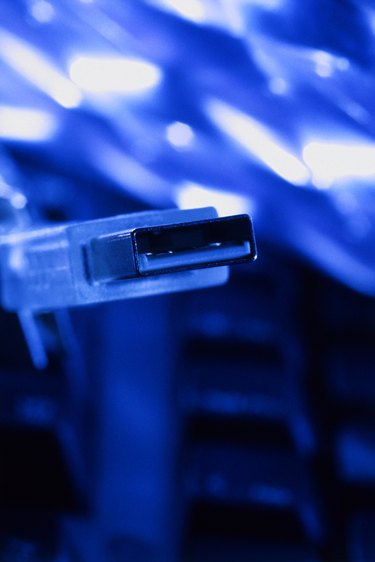
USB connectors follow a master/slave relationship. That means that one device, usually a personal computer, acts as the master by controlling information in and out of a USB port. The USB peripheral, for example a small flash drive, acts as a slave. It can be operated only by the master or it won't work. In that respect, some USB slaves are useless unless connected to a master device.
USB
Video of the Day
Universal Serial Bus refers to the data transfer method and ports used to connect certain devices to a computer. Sometimes the term "USB" is also used for the connecting cable or even the peripheral device itself. Modern computers usually have several USB ports. In many cases, using a peripheral device with a USB port requires simply plugging it in. Your computer will then search for the driver on the device or use existing drivers to load files. These peripherals are known as USB slaves.
Video of the Day
USB Slaves
The term "USB slaves" covers a whole range of peripheral devices. One of the more common forms of USB slave is the flash or thumb drive. These small units plug in to USB hubs on computers, offering chunks of external storage ranging from 256MB to 16GB and beyond. However, USB slaves also include devices such as webcams, printers or scanners. In each case, the device needs the master computer for full functionality, though some USB slaves such as cameras will work regardless. Some peripherals, such as smartphones, are not strictly slave devices, though they act as such when plugged into a computer.
Interaction
True USB slaves can't interact with each other, only with a master device. So, a USB webcam won't connect to a USB video game controller. Most devices made after the year 2000 use USB 2.0 to communicate, a faster specification than original USB devices featuring higher bandwidth. Some post-2010 USB ports now use USB 3.0, though as of July 2011 this applies only to high-end equipment. USB 3.0 offers transmissions speeds of 5 gigabits per second, significantly faster than USB 2.0's 480 megabits per second.
Connection
Many USB slave devices hook up to a master computer using a connecting cable. Most USB cables have a standard connector at one end designed to fit with the classic USB port on personal computers and similar devices. However, the connector at the other end may vary depending on the type of USB slave. For example, it may have a micro connector at the other end to hook up to a cellphone or smaller device.